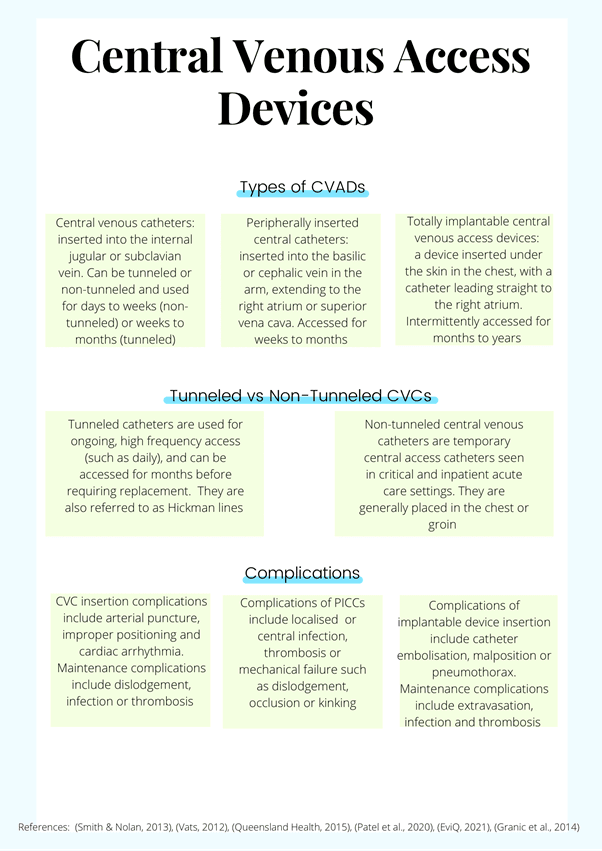Central venous access devices
)
What type of central venous access device does my patient have?
Seen in a variety of clinical settings from critical care to outpatient, central venous access devices (CVADs) are catheters that are inserted into a central or peripheral vein and extend into the superior vena cava (SVC) or cavoatrial junction (CAJ), where the SVC meets the right atrium (RA)1,2. Used for the administration of medication, fluid, blood products or nutrition and for phlebotomy sampling, there are three distinct types of catheters3,4.
CVCs are inserted into the subclavian or jugular vein and can be sub-divided into two categories5,6. Also referred to as a Hickman catheter, tunnelled CVCs are inserted away from the heart, and travel under to skin towards the SVC or RA6. They are used for long-term therapy such as chemotherapy or dialysis7. Non-tunnelled CVCs are used for short-term therapy, often in a critical care setting, and are generally inserted into the neck, with the catheter travelling to the RA or SVC8.
Peripherally inserted central catheters (PICCs) are inserted into the cephalic or basilic vein in the arm, extending to the SVC near the CAJ9. PICCs are generally associated with a lower risk of central line-associated bloodstream infection (CLABSI) and venous thromboembolism (VTE) than CVCs and can be accessed for weeks to months10. Complications include localised or central infection, venous thrombosis, and extravasation caused by malpositioning11.
Totally implantable central venous catheters are indicated in patients who will require central access for months to years12. The device sits under the skin and can be intermittently accessed, which is more comfortable and less limiting to the patient’s daily life12. Complications related to insertion include catheter embolism, malposition, and pneumothorax, while maintenance complications include extravasation, infection or thrombosis13. When compared to other CVADs, implantable devices are recognised as having a significantly lower risk of infection or complications4.
References
1. Gorski L, Hadaway L, Hagle M, Broadhurst D, Clare S, Kleidon T, et al. Infusion Therapy Standards of Practice. Journal of Infusion Nursing 2021;44(1):S66.
2. Baskin K, Jimenez R, Cahill AM, Jawad A, Towbin R. Cavoatrial Junction and Central Venous Anatomy: Implications for Central Venous Access Tip Position. Journal of Vascular and Interventional Radiology 2008;19(3):359-65.
3. Patel A, Patel A, Singh S, Singh S, Khawaja I. Central line catheters and associated complications: a review. Cureus 2019;11(5): e4717.
4. Hord J, Lawlor J, Werner E, Billett A, Bundy D, Winkle C, et al. Central Line Associated Blood Stream Infections in Pediatric Hematology/Oncology Patients with Different Types of Central Lines. Pediatric Blood and Cancer 2016;63(9):1603-067.
5. Smith R, Nolan J. Central venous catheters. BMJ 2013;11(347): e6570.
6. Vats H. Complications of catheters: tunneled and nontunneled. Advances in Chronic Kidney Disease 2012;19(3):188-94.
7. Ash S. Advances in tunneled central venous catheters for dialysis: design and performance. Seminars in Dialysis 2008;21(6):504-15.
8. Wall C, Moore J, Thachil J. Catheter-related thrombosis: A practical approach. Journal of the Intensive Care Society 2016;17(2):160-7.
9. Queensland Health. Peripherally inserted central venous catheters (PICC); 2015; Available from: https://www.health.qld.gov.au/__data/assets/pdf_file/0032/444497/icare-picc-guideline.pdf.
10. Patel N, Petersen T, Simpson P, Feng M, Hanson S. Rates of venous thromboembolism and central line-associated bloodstream infections among types of central venous access devices in critically ill children Pediatric Critical Care 2020;48(9):1340-8.
11. Grau D, Clarivet B, Lotthe A, Bommart S, Parer S. Complications with peripherally inserted central catheters (PICCs) used in hospitalised and outpatients: a prospective cohort study. Antimicrobial Resistance and Infection Control 2017;6(18).
12. EviQ. Central venous access devices. NSW Health; 2021; Available from: https://www.eviq.org.au/clinical-resources/central-venous-access-devices-cvads/112-central-venous-access-devices#types-of-cvads.
13. Granic M, Zdravkovic D, Krstajic S, Kostic S, Simic A, Kovcin V. Totally implantable central venous catheters of the port-a-cath type: complications due to its use in the treatment of cancer patients. Journal of the Balkan Union of Oncology 2014;19(3):842-6.
| Tags:central vascular access devices |








